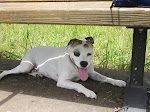Song in my head: I'm the slime oozing out from your TV Set........Frank Zappa
Mad Cow 2004
Bio-Rad receives USDA permit for BSE test: Company's automated TeSeE(R) test available for national surveillance program
HERCULES, Calif. -- California-based Bio- Rad Laboratories, Inc. (Amex: BIO and BIOb), announced today that its rapid TeSeE(R) test used for the detection of BSE (bovine spongiform encephalopathy, also known as mad cow disease) has been licensed by the United States Department of Agriculture (USDA) for use in the National Veterinary Service Laboratories (NVSL) in Ames, Iowa and all the NVSL network laboratories as part of the USDA's newly enhanced BSE testing program. It is estimated that this new program will test approximately 400,000 animals over the next 12-18 months.
"We are pleased that our test has met the stringent requirements of the USDA qualification process," said Brad Crutchfield, Bio-Rad's Vice President of Life Science. "Bio-Rad has extensive experience working with more than 500 labs in 25 countries around the world that screen for BSE. We are well prepared to provide the USDA with the same high level of support that our other customers receive."
Bio-Rad is the leading provider of tests used for detecting TSEs (Transmissible Spongiform Encephalopathies). To date, the company has provided more than 22 million BSE tests to laboratories throughout Europe and Japan. Independent field studies have shown the Bio-Rad BSE test to have the highest level of sensitivity and specificity of any rapid screening test available. The test detects the presence of the resistant form of prion protein, or PrPres, linked to BSE and can identify these prions at extremely low levels. This capability to detect very low levels of prions helps assure that BSE infected animals do not go undetected. The Bio-Rad test is also the easiest testing method to adapt to mass screening programs and can produce results in just four hours.
"The test's speed, ease-of-use, high degree of sensitivity and accuracy have placed it in the highest scientific regard and will aid in the USDA's efforts to conduct a reliable and highly effective surveillance program," added Crutchfield.
Bio-Rad also supplies tests for other TSEs, including its Chronic Wasting Disease (CWD) test which is the only test approved by the USDA for use on all three species affected with CWD (white tailed deer, mule deer and elk).
"In Colorado we have tested nearly 47,000 deer and elk in the last 18 months using Bio-Rad's CWD test," said Dr. Barbara Powers, Director of Colorado State University's Veterinary Diagnostic Laboratory, who worked closely with the Colorado Division of Wildlife on the 2002 field validation studies of Bio-Rad's CWD test. "The test has proven to be extremely accurate, fast, very easy to perform and it is also efficient and cost effective, added Powers."
"In cooperation with the University of Nebraska Veterinary Diagnostic Laboratory, the Nebraska Game and Parks Commission has utilized the Bio-Rad ELISA test for the past two years, testing over 8,000 mule and white tailed deer," added Bruce Morrison, Nebraska's CWD Coordinator. "The results from the test are fast and accurate, which is efficient for both the agency and the hunters that are waiting for results. The product support from the company is excellent and we have saved thousands of dollars in our budget using this test."
(link via FSnet by subscription)
Besides cows, they use this test on deer and elk. This reaffirms my opinion that BSE lingers. If I'm wrong I'll eat an elk hamburger.
Green Beret first U.S. patient to receive trial drug for CJD
A Bronze Star-decorated Special Forces soldier who served in Afghanistan and Iraq is reportedly the first person in the nation to receive a new drug treatment for Creutzfeldt-Jakob disease.
The Nashville Tennesean reported that Staff Sgt. James Alford, 25, a soldier stationed at Fort Campbell, Ky., is resting at his parents' home in Karnack, Texas, after the first round of treatments.
Doctors hope the new treatment will stall or perhaps reverse effects of the brain-wasting disease. If so, it would be the first treatment to give hope to CJD victims, who usually die within a year of diagnosis.
Last spring, before Alford lost his ability to speak, he told his family he had eaten a sheep brain while assigned to Oman in 2001. However, there is no evidence to link the direct transmittal of the disease from a sheep to a human, according to the Centers for Disease Control and Prevention.
The new treatment includes pentosan polysulfate. Although the drug is commonly used in pill form in the United States for relief of pain due to chronic bladder inflammation and as an anti-coagulant, the drug in liquid form has not been approved for use in this country. (link via Fsnet by subscription)
CJD and mad cow are variants of a similar disease. Here's a description:
Both diseases are caused by an unusual disease agent known as a prion, which can apparently lie dormant for a decade or more before rapidly growing in pockets and turning the brain into a spongelike mass. |link|
The first paragraph is startling enough:
Although U.S. health officials say no one has gotten mad cow disease from American beef, a Cinnaminson woman says seven people died of a closely related disease after eating at the Garden State Race Track in Cherry Hill. |link|
Democrats Now Have a Path to a Senate Majority
-
Dan Pfeiffer lays out the path quite neatly. It’s only a possible path, no
guarantees, but that it’s even possible should spur all of us to work our
ass...
2 hours ago


No comments:
Post a Comment